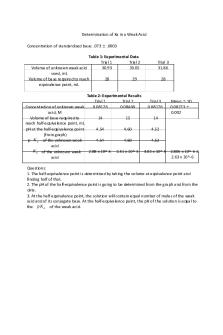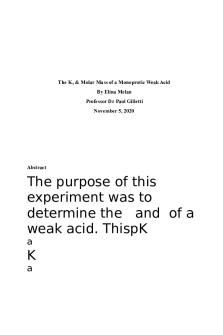Determination of Ka in a Weak Acid PDF

| Title | Determination of Ka in a Weak Acid |
|---|---|
| Course | Experimental Chemistry II |
| Institution | Indiana University - Purdue University Indianapolis |
| Pages | 3 |
| File Size | 117.1 KB |
| File Type | |
| Total Downloads | 50 |
| Total Views | 233 |
Summary
Determination of Ka in a weak acid report...
Description
Determination of Ka in a Weak Acid Concentration of standardized base: .073 .0003 Table 1: Experimental Data Trial 1 Trial 2 Volume of unknown weak acid 30.93 33.05 used, mL Volume of base required to reach 28 29 equivalence point, mL
Trial 3 31.86 28
Table 2: Experimental Results Trial 1 Trial 2 Trial 3 Mean SD Concentration of unknown weak 0.08176 0.08468 0.08176 0.08273 acid, M 0.002 Volume of base required to 14 15 14 reach half-equivalence point, mL pH at the half-equivalence point 4.54 4.60 4.52 (from graph) 4.54 4.60 4.52 p K a of the unknown weak acid K a of the unknown weak 2.88 x 10^-5 2.51 x 10^-5 3.02 x 10^-5 2.805 x 10^-5 2.63 x 10^-6 acid Questions: 1. The half-equivalence point is determined by taking the volume at equivalence point and finding half of that. 2. The pH of the half-equivalence point is going to be determined from the graph and from the data. 3. At the half equivalence point, the solution will contain equal number of moles of the weak acid and of its conjugate base. At the half-equivalence point, the pH of the solution is equal to the p K a of the weak acid.
Introduction Strong acids, like hydrochloric acid, can dissociate completely in a dilute aqueous solution. Weak acids can only dissociate partially and exist in a mixture of molecular acid, hydronium ion, and the anion of the acid. Equation 1 is a way to explain the acid dissociation constant for a general weak acid HA (1). +¿ ¿ H3O ¿ −¿ ¿ A ¿ ¿ K a=¿ In an equilibrium reaction,
Ka
(1)
can be determined by monitoring the pH while a weak acid is
being titrated. At a point in the titration, the number of moles of the base added is half the number of moles of the acid originally present. This means that 50% of the acid has been titrated
to produce A^- and the other 50% remains as HA.
−¿¿ A and the ratio ¿
−¿¿ A ¿ in equation 1 will ¿ ¿
be equivalent or unified. This point is known as the half equivalence point of the titration. When the volume at the equivalence point is known the pH, which is equal to p K a
can be found. In
this experiment a titration was done with a sample of a weak acidic solution and standardized with a diluted NaOH, which was made in advance. After the completion of all three titrations the concentration of the weak caid and the
K a for said weak acid can be found. The purpose of
this experiment is to use titration to determine the
Ka
of an unknown weak acid with a pH
meter and to develop and interpreted the titration curve. In a lab setting, a titration can be used to determine unknown concentration of a chemical or chemicals in blood or urine. Discussion This experiment had many ways for error. One way is not enough care was given when adding the NaOH when the titration was getting close to the equivalence point. When the equivalence point is reached the jump is very fast and it is very easy to miss. In the second trial with the phenophlain indicator, the beaker was spilled at the equivalence point. It was noted that the beaker was swirled before spilled so the ratio was accurate. The concentration of NaOH was
previously calculated was used to calculate the concentration of the unknown acid for all three titrations. The mean concentration was 0.08273 M and the standard deviation was .002 using the equation below (2). M a V a=M b V b
(2)
Using the half volume, the equivalence point for all three titrations were found. The pH was then calculated from the half volume and the graphs, with this known the − p Ka
10
. The mean
Ka
Ka
was found using
was found to be 2.805 x 10^-5 and the standard deviation was found
the be 2.63 x 10^-6. Conclusion The
Ka
of an unknown weak acid can be determined through a titration. By
monitoring the pH of the base being titrated the equivalence point can be found. Once the equivalence point is found then the half equivalence point can be. The pH can be determined then the
K a can be calculated by using the relationship pH=p K a ....
Similar Free PDFs
Popular Institutions
- Tinajero National High School - Annex
- Politeknik Caltex Riau
- Yokohama City University
- SGT University
- University of Al-Qadisiyah
- Divine Word College of Vigan
- Techniek College Rotterdam
- Universidade de Santiago
- Universiti Teknologi MARA Cawangan Johor Kampus Pasir Gudang
- Poltekkes Kemenkes Yogyakarta
- Baguio City National High School
- Colegio san marcos
- preparatoria uno
- Centro de Bachillerato Tecnológico Industrial y de Servicios No. 107
- Dalian Maritime University
- Quang Trung Secondary School
- Colegio Tecnológico en Informática
- Corporación Regional de Educación Superior
- Grupo CEDVA
- Dar Al Uloom University
- Centro de Estudios Preuniversitarios de la Universidad Nacional de Ingeniería
- 上智大学
- Aakash International School, Nuna Majara
- San Felipe Neri Catholic School
- Kang Chiao International School - New Taipei City
- Misamis Occidental National High School
- Institución Educativa Escuela Normal Juan Ladrilleros
- Kolehiyo ng Pantukan
- Batanes State College
- Instituto Continental
- Sekolah Menengah Kejuruan Kesehatan Kaltara (Tarakan)
- Colegio de La Inmaculada Concepcion - Cebu















